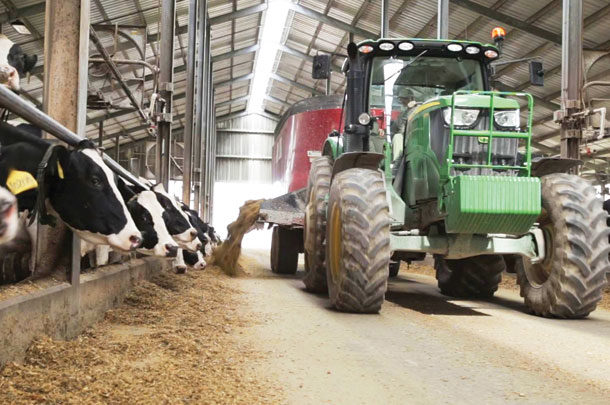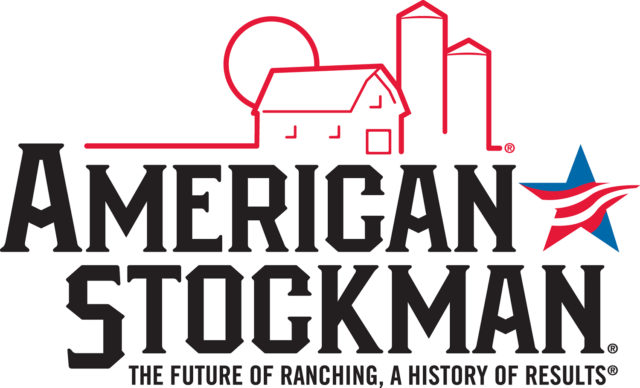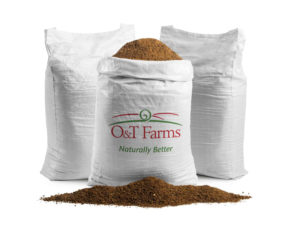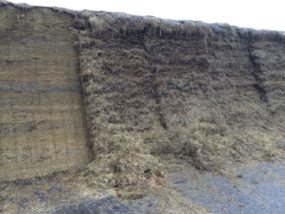All too often, feeders find themselves in a cyclical battle, providing excess feed some days and then running short of feed other days, without understanding that most of this variability is often the result of changes in feed delivery being out of sync with the intake behaviour of the animals.
Once certain feeding principles are understood, it is possible to adapt the calling of feed changes according to predictable changes in feeding behaviour and minimize unnecessary variation in feed delivery.
Principle 1: Individual animal requirements in a feeding group should not vary greatly over the short term.
An individual animal’s nutritional requirements are made up of a maintenance component based on its bodyweight and daily milk production plus growth, in the case of heifers, or bodyweight recovery. Over the short term (e.g., one to two weeks), these requirements do not change appreciably.
In the case of a lactating group, as long as the composition of the group, based on parity and average milk production, does not change appreciably over time, neither would the nutritional requirements or the TMR intake requirements.
Principle 2: A period of intake restriction will be followed by increased hunger and a period of compensatory overconsumption.
Though individual nutritional requirements should not vary, individual and group intakes may change abruptly due to handling or weather events, as well as introduction of members to, or removal from, the group.
-
Handling: Any time the normal routine of a pen of cattle is interrupted by handling, such as for foot trimming, it is common for intakes to drop for a day or two. This may be followed by one or two days of higher-than-normal intake, after which intakes will generally return to their previous level.
-
Weather: When permitted, cattle can dramatically increase intake 24 to 48 hours ahead of a storm or other significant change in weather, and intake will drop as much as 30 percent below normal during the weather event.
Afterwards, pent-up hunger will cause intake potential to again rise above normal and then gradually return to normal as the hunger is satisfied. In contrast, short-term heat stress can cause intakes to decrease temporarily, while long periods of heat stress can cause a general reduction in intake that can last for an extended period of time.
-
Introductions and removals: Introductions of individuals to, or removal from, the group will change the aggregate intake of the group, but the effects of these changes are often smaller than anticipated. A net change of one animal in a group of 100 cows might seem, on average, to only require a 1 percent change in feed delivery.
However, in a one-group lactating herd, cows entering (fresh) or leaving (drying off) would not normally be expected to consume the same amount of feed as the average for the herd, perhaps only 60 to 80 percent. Yet it is common to see minimum feed delivery changes of 3 to 5 percent on some farms, with no relationship to the change in numbers of animals being fed.
Principle 3: Feeder reaction will always lag behind animal behaviour and will amplify feed delivery variability if one simply follows animal intake patterns.
When feed is unlimited and always available, periodic changes in intake take place without notice and readily correct themselves. However, when feeders try to feed to appetite and minimize feed refusals on a daily basis, they often become the source of cyclic intake by simply following and responding to the feeding behaviour they see and create a repeating feed shortage.
Problems generally arise when the person making feed changes notices that a group of animals has consumed their feed earlier than expected or the bunk is “slick” (licked clean) when they come to feed. They then increase the amount fed by a standard amount, often 3 to 5 percent, without considering why the feed consumption would have changed.
- Excessive increases in feed allocation: If the subsequent increase in feed is too large, for example due to a handling event, a relatively small change in group size or gradual change in nutritional requirements, refusals will begin to accumulate as pent-up hunger is satisfied over a few days; then the feeder decreases the amount fed by a similar amount, and the cycle starts to repeat.
- Chasing hungry cows: If the initial increase in feed allocation is too small to overcome the immediate intake demand of the group, which can happen prior to the onset of extreme weather events, feeders will often “chase the cows” with multiple successive increases in feed allocation, then be faced with large amounts of refusals when the weather event hits.
They then start aggressively reducing feed to correct for the increased amount of refusals, only to be faced with an even larger slick bunk problem once the weather event has passed, thereby developing a pronounced feeding cycle that can last for weeks or months.
Cyclical intake patterns, where groups of cattle systematically go without adequate feed to meet their nutritional requirements, are reflected in milk production. Lack of feed will reduce milk production on those days where feed delivery is inadequate, but will not generally be increased beyond normal when excess feed is provided. Often, ability of individual animals to achieve potential peak milk production will also be impaired.
Procedures for “calling feed” have been used for decades in the feedlot industry to control feed delivery and intake variability, but are rarely applied on dairy farms where they have equal value, as follows:
1. Keep a record of daily feed delivery (as-fed and dry matter) to know what stable, average daily feed consumption should be.
2. Chose a specific time of day to make decisions regarding feed allocation changes (to call feed) for each pen on the farm.
Ideally, this will be about two hours before the main feed delivery for the day and be timed to permit the person calling feed, or someone else, to observe the pens prior to that time to note exactly when any pen actually runs out of feed. For smaller farms, this might make the afternoon the best time for calling feed and main feed delivery for the day.
3. Make feed changes daily in proportion to changes in animal composition and milk production of the group, often in increments as little as 0.5 to 1 percent, and resist making consecutive changes, especially downward, until intake has stabilized.
4. Resist changing feed delivery in response to abrupt changes in feeding behaviour (intake), as it creates cyclical intake patterns, digestive problems and lost productivity.
5. When abrupt changes in intake occur, first try to maintain the daily amount of feed delivery, but delay the time of feeding or amount fed at the first feeding of the day so that feed left in the bunk is consumed before fresh feed is delivered. Remember that normal intake is expected to return within a couple days of handling or the passing of a weather event, as indicated by the feeding records.
What one sees happening in the feedbunk (i.e., level of feed consumption) is highly influenced by events that have occurred 24 to 48 hours earlier. As a result, if one responds only to what one sees in the feedbunk immediately prior to feeding, one will often lag behind what the animals need over the coming 24 hours.
One must also consider why the level of intake may have changed in the past, or might suddenly change, and act accordingly to deliver the appropriate amount of feed that should be required going forward; thus the science, and art, of calling feed on a dairy. ![]()
PHOTO: Dairy herd being feed at the feed bunk. Photo courtesy of Jaylor.

-
Alan S. Vaage
- Ruminant Nutritionist
- Jaylor Fabricating Inc.
- Email Alan S. Vaage











